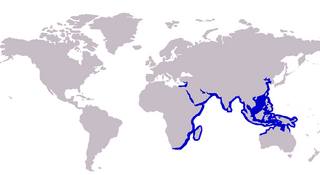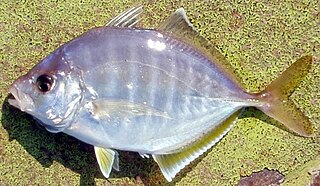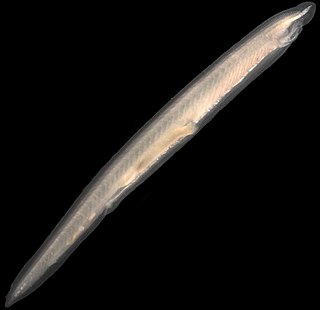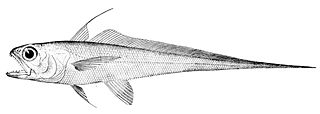
The angelsharks are a group of sharks in the genus Squatina of the family Squatinidae. They commonly inhabit sandy seabeds close to 150 m (490 ft) in depth. Many species are now classified as critically endangered by the International Union for Conservation of Nature. Once common over large areas of the Northeast Atlantic from Norway, Sweden, Morocco and the Canary Islands, to the Mediterranean and Black Seas, there is now significant fishing pressure which has resulted in significant population decline.

A cephalochordate is an animal in the chordate subphylum, Cephalochordata. They are commonly called lancelets. Cephalochordates possess 5 synapomorphies, or primary characteristics, that all chordates have at some point during their larval or adulthood stages. These 5 synapomorphies include a notochord, dorsal hollow nerve cord, endostyle, pharyngeal slits, and a post-anal tail. The fine structure of the cephalochordate notochord is best known for the Bahamas lancelet, Asymmetron lucayanum. Cephalochordates are represented in modern oceans by the Amphioxiformes and are commonly found in warm temperate and tropical seas worldwide. With the presence of a notochord, adult amphioxus are able to swim and tolerate the tides of coastal environments, but they are most likely to be found within the sediment of these communities.

The lancelets, also known as amphioxi, consist of some 30 to 35 species of "fish-like" benthic filter feeding chordates in the order Amphioxiformes. They are the modern representatives of the subphylum Cephalochordata. Lancelets closely resemble 530-million-year-old Pikaia, fossils of which are known from the Burgess Shale. Zoologists are interested in them because they provide evolutionary insight into the origins of vertebrates. Lancelets contain many organs and organ systems that are closely related to those of modern fish, but in more primitive form. Therefore, they provide a number of examples of possible evolutionary exaptation. For example, the gill-slits of lancelets are used for feeding only, and not for respiration. The circulatory system carries food throughout their body, but does not have red blood cells or hemoglobin for transporting oxygen. Lancelet genomes hold clues about the early evolution of vertebrates: by comparing genes from lancelets with the same genes in vertebrates, changes in gene expression, function and number as vertebrates evolved can be discovered. The genome of a few species in the genus Branchiostoma have been sequenced: B. floridae,B. belcheri, and B. lanceolatum.

The sand devil or Atlantic angel shark is a species of angelshark, family Squatinidae, native to the northwestern Atlantic Ocean. It occurs off the eastern United States, in the northern Gulf of Mexico, and possibly in parts of the Caribbean Sea. This bottom-dwelling shark is found in shallow inshore waters in summer and fall, and deep offshore waters in winter and spring. The sand devil's flattened body and enlarged pectoral and pelvic fins give it a ray-like appearance. There is a band of enlarged thorns running along the middle of its back. It is gray or brown in color, with scattered small dark spots. This species reaches 1.2–1.5 m (3.9–4.9 ft) in length.

The red Irish lord is a species of marine ray-finned fish in the family Agonidae. It is found in the northern Pacific Ocean, from Russia to Alaska and as far south as Monterey Bay. It is a distinctly red fish, with brown, yellow, white, and black mottling, that is generally around 30 cm (12 in) long, though specimens can grow to up to 51 cm (20 in) in length. German naturalist Wilhelm Gottlieb Tilesius formally described it in 1811. Carnivorous, it hides camouflaged among rocks on the ocean floor and lashes out to seize its prey—crabs, fish and shrimp.

The thornback guitarfish is a species of ray in the family Platyrhinidae, and the only member of its genus. Despite its name and appearance, it is more closely related to electric rays than to true guitarfishes of the family Rhinobatidae. This species ranges from Tomales Bay to the Gulf of California, generally in inshore waters no deeper than 6 m (20 ft). It can be found on or buried in sand or mud, or in and near kelp beds. Reaching 91 cm (36 in) in length, the thornback guitarfish has a heart-shaped pectoral fin disc and a long, robust tail bearing two posteriorly positioned dorsal fins and a well-developed caudal fin. The most distinctive traits of this plain-colored ray are the three parallel rows of large, hooked thorns that start from the middle of the back and run onto the tail.

The vermilion snapper, the clubhead snapper, night snapper, Brian’s red fish or beeliner is a species of marine ray-finned fish, a snapper belonging to the family Lutjanidae. It is native to the western Atlantic Ocean.

The northern whiting, also known as the silver whiting and sand smelt, is a marine fish, the most widespread and abundant member of the smelt-whiting family Sillaginidae. The northern whiting was the first species of sillaginid scientifically described and is therefore the type species of both the family Sillaginidae and the genus Sillago. The species is distributed in the Indo-Pacific region from South Africa in the west to Japan and Indonesia in the east, also becoming an invasive species to the Mediterranean through the Suez Canal. The northern whiting inhabits coastal areas to 60 m, but is most often found in shallow water around bays and estuaries, often entering freshwater. It is a carnivore, taking a variety of polychaetes and crustaceans. The species is of major economic importance throughout the Indo-Pacific. It is most frequently taken by seine nets and cast nets and marketed fresh.

The whitefin trevally, also known as the horse trevally, is a species of deep water offshore fish in the jack family Carangidae. The species inhabits the tropical to temperate waters of the Indo-Pacific and central Pacific, ranging from South Africa in the west to Hawaii in the east. The whitefin trevally is a moderate-sized fish, growing to 37 cm, and is distinguished by a number of morphological traits, including fin size, gill raker count, and colour. It inhabits the continental shelf and slope at depths to 200 m over sand and mud substrates, where it preys on fish, crustaceans, and cephalopods. Studies in Japan indicate a length at sexual maturity of 17.4 cm on average, with spawning occurring between May and October, with each individual spawning multiple times. Whitefin trevallies are of high importance to fisheries in Japan, where they are taken by trawlers, although the catch numbers have halved since the 1980s. It is of minor importance elsewhere throughout its range, but is considered a good table fish.

The coral hawkfish, the pixy hawkfish or sharp-headed hawkfish, is a species of marine ray-finned fish, a hawkfish belonging to the family Cirrhitidae. It is native to tropical reefs of the Indian Ocean and the Pacific Ocean. It occasionally is found in the aquarium trade.

The false scad, also known as the spotfin scad, ten-finned horse mackerel and yellow horse mackerel, is a species of medium-sized marine fish classified in the jack family Carangidae. The false scad is distributed throughout the tropical and temperate waters of the eastern Atlantic Ocean from Namibia in the south to Spain and throughout most of the Mediterranean in the north. The species has an atypical body form compared to other species of Caranx, and can be distinguished from these on its elongate 'scad-like' body shape alone. Distinguishing the species from members of Decapterus and Trachurus is more difficult, requiring detailed anatomical analysis. The false scad is known to grow to a length of 60 cm and a weight of 1 kg. The species lives both pelagically and demersally in continental shelf waters, ranging from depths of 15 to 200 m. It is a predatory fish, taking small fishes, crustaceans including euphausiids and shrimps, and cephalopods as its main prey, with significant dietary shifts as it ages. The false scad reaches sexual maturity at 2 years of age, with spawning occurring between April and July in shallow inshore waters, where the juveniles remain. The species is of major importance to fisheries throughout its range, but particularly from Morocco to Senegal, with annual catches ranging from 500 to 19000 t. The species is caught using trawls, seine nets and gill nets and sold fresh, frozen or salted.

Branchiostoma is one of the few living genera of lancelets. It is the type genus of family Branchiostomatidae.
Cancelloxus burrelli, the Slender platanna-klipfish, is a species of clinid found in subtropical waters of the Atlantic Ocean along the South African coast from the Orange River to Algoa Bay in South Africa. It can be found from the intertidal zone down to about 20 metres (66 ft). This species can reach a maximum length of 12 centimetres (4.7 in) TL.
Branchiostoma floridae, the Florida lancelet, is a lancelet of the genus Branchiostoma. The genome of this species has been sequenced, revealing that among the chordates, the morphologically simpler tunicates are actually more closely related to vertebrates than lancelets. An embryo of a Florida amphioxus has a larval pharynx with gill slits that is asymmetrical. The gill slits in the larval pharynx form in the center of the embryo when it is in its earliest stage of development (primordial) meaning the thick layer of endoderm is overlapped by a thin layer; which aids into making the B. floridae asymmetrical from left to right. The lancelet Branchiostoma floridae maintains a high level of Fox transcription factor gene diversity, with 32 distinct Fox genes in its genome, and 21,229 clusters of cDNA clones, making it very useful to the research community.

Branchiostoma lanceolatum, the European lancelet or Mediterranean amphioxus, is a lancelet in the subphylum Cephalochordata. It is a marine invertebrate with a notochord but no backbone and is used as a model organism to study the evolutionary development of vertebrates.

The luminous hake is a West Atlantic member of the Merluccidae family. It is the only member of its genus.

The Gulf killifish is one of the largest members of the genus Fundulus; it is capable of growing up to 7 inches (18 cm) in length, whereas the majority of other Fundulus reach a maximum length of 4 inches (10 cm). Therefore, F. grandis is among the largest minnows preyed upon by many sport fish, such as flounder, speckled trout, and red drum. Fundulus derives from the Latin meaning "bottom," and grandis means "large". The Gulf killifish is native to the Gulf of Mexico from Texas to Florida and the eastern coast of Florida and the Caribbean Sea in the Atlantic Ocean. Threats to the survival of the Gulf killifish include extreme changes in salinity, changes in temperatures, and toxic events such as the hypoxic dead zone in Louisiana and the Deepwater Horizon oil spill. The Gulf killifish is currently being used to test the effects of oil and oil dispersants on the physiology of marine species affected by these substances. This is significant to conservation biology, because with the continued extraction of oil and other natural resources from North American waters, it has become increasingly important to understand the risks and consequences in worst-case scenarios, such as the Deepwater Horizon oil spill, and the lasting effects on the marine ecosystem.

The bay whiff is part of the family Paralichthyidae. This family is known as "left-eye flounders". They are one of the most common flatfish of the Gulf of Mexico. They are benthic ambush predators with the ability to camouflage themselves on or just below the surface. They are often solitary animals with few individuals. They vary in color from light to dark in life and are brownish in color after death. They have two dark spots on the caudal peduncle and a light spot under the pectoral fin. The average size of the Bay whiff is 15 cm and the maximum recorded length is 20 cm. The lateral line is straight along the body. It has a large mouth. The opercle on the blind side has no cirri. Their pelvic fins are also asymmetrical.

Myoxocephalus jaok, the plain sculpin, is a species of marine ray-finned fish belonging to the family Cottidae, the typical sculpins. This species is found in the northern Pacific Ocean and adjacent Arctic Ocean.

The Arctic staghorn sculpin is a species of marine ray-finned fish belonging to the family Cottidae, the typical sculpins. This sculpin is found in the Arctic Ocean and the northern Atlantic Ocean.















